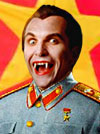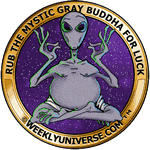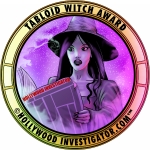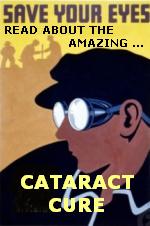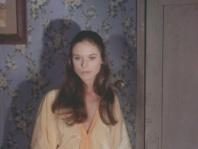|
Crucible of Terror Film review by Thomas M. Sipos |
|
MENU Books Horror Film Festivals and Awards
Pursuits
Blogs Horror Film Festivals and Awards
Other
|
Crucible of Terror (British 1971, dir: Ted Hooker; cast: Mike Raven, James Bolam, Mary Maude, Kenneth Keeling, Ronald Lacey, Marissa Stribling)
Victor Clare (former BBC DJ, Mike Raven) is an artist. He "worships" beauty. He wants to "preserve" and "possess" beauty. That's why he never sells his work. It's not his job, it's his devotion. Fortunately, his workload is manageable because his taste in beauty is narrow. No trees or sunsets or daffodils. No landscapes, or still lives, or abstracts. He only paints women. Young women. Young nekkid women. And nothing but. Hey, he's an artist. Actually, Victor doesn't just paint. He also sculpts. If you've seen House of Wax (1953), you've got a rough idea of his technique. It's one reason the film is called Crucible of Terror. A crucible is "a vessel used for melting or calcining materials at high temperatures." It's also "the bottom of an ore furnace in which the molten metal collects." Victor owns one of each. A crucible is also "a severe test or trial." People trapped in a tense, suffocating social setting are said to be in a crucible. That pretty much describes Victor's dinner parties. Millie (Mary Maude) endured one of those. In fact, she suffered through an entire weekend with Victor and family. One can't blame her if she ends up dumping Jack (James Bolam). Here's how it all began... Jack, the owner of a London art gallery, is in a financial pickle. He could escape debt if only he had more works by that mysterious reclusive artist, whose bronze sculpture of a nekkid woman sold for a good price. But Victor (who else?) refuses to sell his works. Luckily for Jack, Victor's no-good drunken son, Michael (Ronald Lacey), has been stealing dad's works, to sell to Jack. But Michael can't sell too many, lest Victor notice. Michael agrees to arrange a meeting between Jack and Victor at the family cottage, out in the country. Fresh air, craggy headland seashore, abandoned tin mine said to be haunted... Anyway, they all drive up for the weekend: Jack and Millie (his fiancée), Michael and wife Joanna (Melissa Stribling). At the cottage they meet Victor, his wife Dorothy (Betty Alberge), his artist's model (i.e., lover) Marcia (Judy Matheson), and Bill (John Arnatt), the milquetoast "family friend." Bill's a cardigan-wearing wimp (despite his extensive samurai sword collection) who's been pining after Dorothy for thirty years. He doesn't even mind that Dorothy's richest conversations are with her dolls and stuffed animals, whom she feeds at the dinner table.
Crucible of Terror is a dark, and darkly humorous, domestic drama. Victor is a bullying sexual predator. During dinner he squeezes between Joanna and Millie, flirting with both women before their menfolk, neither of whom protest (Michael is intimidated by his dad; Jack doesn't want to ruin the deal). Victor exults in having "two beautiful women under one roof," pointedly ignoring that Marcia and Dorothy are also present. The bisexual Marcia smirks, having seen Victor's other lovers come and go. Dorothy feeds her stuffed dog. Upon seeing which, Victor explodes that he's told her not to bring "that thing" to the dinner table. Tearstruck, Dorothy frets that Victor's hurt her plush toy's feelings. Fun party. And to think, had it not been for Jack, Millie might have spent yet another boring weekend shopping in London! Amid all this domestic discomfort, an unseen killer is racking up a body count. However, this being a horror film, everyone is blissfully ignorant of it, simply assuming that so-and-so left after "having a row" last night. Some horror fans complain that Crucible of Terror contains "little horror," but the body count is generous. Just not very gory. And there's much "domestic horror" and cruel humor. That can compensate for tepid gore, no? After Joanna disappears, Victor focuses his, ehr, artistic attentions on Millie. Victor induces Jack to return to London (sans Millie) by agreeing to sell some paintings to him, provided he raises 2,000 pounds, in cash, today (Sunday). Leaving, Jack suggests to Millie (only half-jokingly) that she "be nice" to Victor, so as to help seal the deal.
Initially, I didn't much like or understand Crucible of Terror, but my appreciation grows with each viewing. Sunny outdoor scenes dominate the early scenes. People wandering along cliffs and beaches. But a palpable claustrophobia increasingly stifles us as the story progresses. The latter scenes occur at night or underground in the mine, paralleling the increasingly unpleasant domestic situation and Victor's intensifying flirtations toward Millie. Interspersed are those periods of relief, such as the false rescue of Jack's phone call. Or when Jack is in London and we feel we've "escaped" with him (yet feel guilty about leaving Millie behind with Victor). Crucible of Terror is often odd or confusing. At the beach, Michael taunts Marcia over her failed lesbian overtures toward Millie. So Marcia "playfully" pelts stones at Michael, still stoning him even after he's screaming and injured. (Even drunk, why doesn't he think to stone her back?) And what's with Dorothy's stuffed animals? Rough editing adds to our confusion. Millie exits the mine though a door in Victor's house, then goes upstairs. Then she enters the furnace in the mine. The film is full of such edits, whole scenes apparently missing.
A recent VHS copy (distributed by Simitar) suffers from poor resolution, with the washed-out colors of 16mm TV station prints. Perhaps it's due to Simitar's EP speed. My older VHS copy at SP speed is sharper. Reportedly, the DVD version is clear, with many censored (in the US) scenes restored. However, in Fragments of Fear: An Illustrated History of British Horror Films, Andy Boot writes: "photographer Peter Newbrook is a skilled man, but the quality of film stock he gets looks like super-8 blown up at times. But perversely this only adds to the strange feel of a film that seems to work by default." Maybe Boot saw a version that's since been cleaned up in the DVD. But he is right. The film's faded visuals (and muddy audio and rough editing) curiously enhance its surreal oddness and stifling claustrophobia. Thus, one wonders how much is intentional, or ineptitude, or censorial editing. Because it works ... sort of. Mike Raven's tall large frame and booming DJ voice make him an imposing villain. It's easy to see why Victor intimidates and/or dominates others. Mary Maude's timid Millie ironically resembles Theresa, Maude's victim in The House That Screamed.
A correction. John Stanley's Creature Features guide states: "An insane sculptor coats his victims with wax or bronze when his body is inhabited by the spirit of a dead artist." No, Victor is never possessed. And there's no dead artist. Many Ebay sellers claim Crucible of Terror is "out of print" or "rare." On the contrary, new VHS copies have long been available on Amazon, and now there's also DVD. I've seen several video box covers at Ebay. This film has been released often, and by several distributors. Copies are plentiful, name your own price. Crucible of Terror is not to be confused with another British horror film, Crucible of Horror. Review copyright by Thomas M. Sipos
|
"Communist Vampires" and "CommunistVampires.com" trademarks are currently unregistered, but pending registration upon need for protection against improper use. The idea of marketing these terms as a commodity is a protected idea under the Lanham Act. 15 U.S.C. s 1114(1) (1994) (defining a trademark infringement claim when the plaintiff has a registered mark); 15 U.S.C. s 1125(a) (1994) (defining an action for unfair competition in the context of trademark infringement when the plaintiff holds an unregistered mark).
